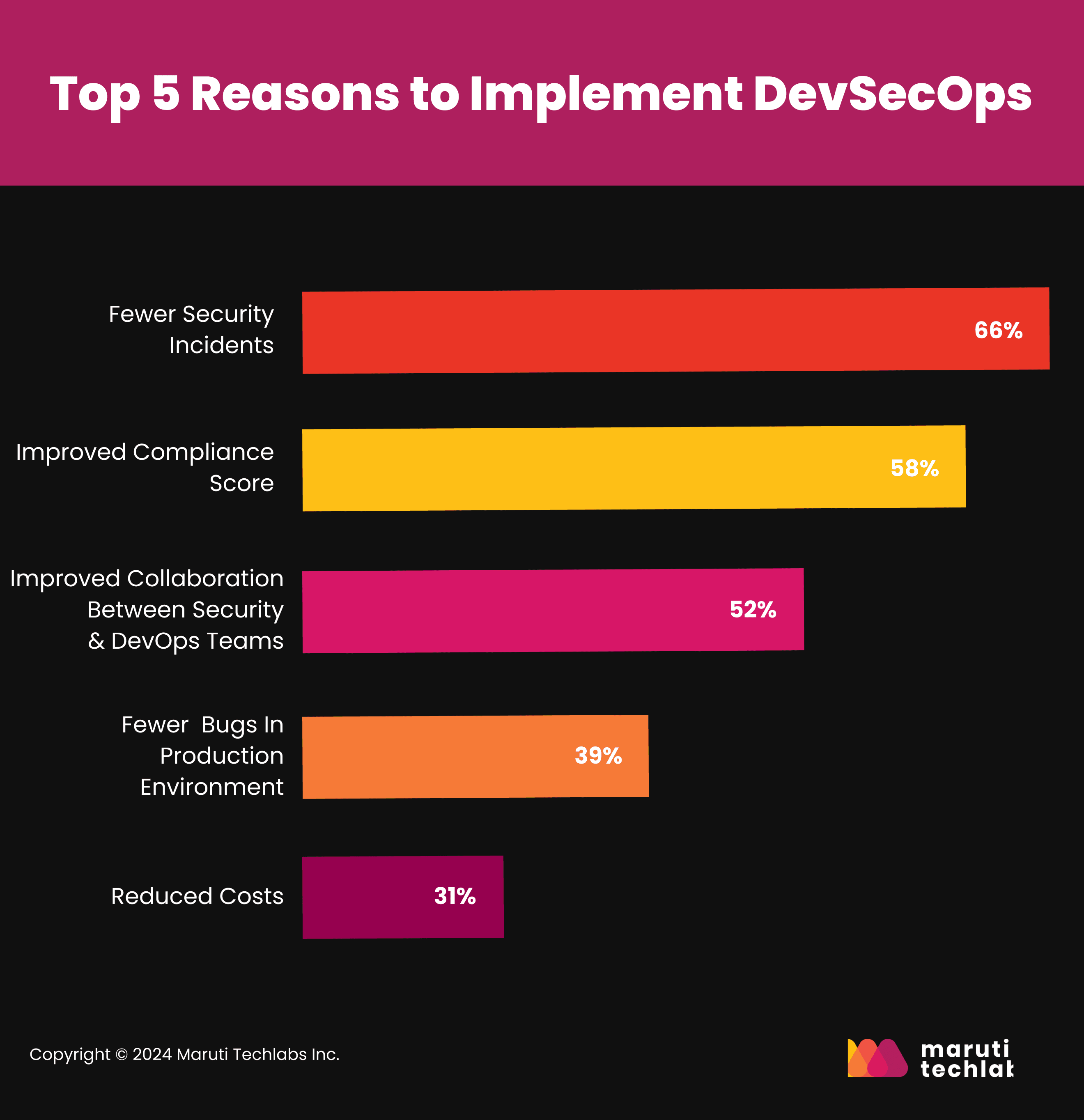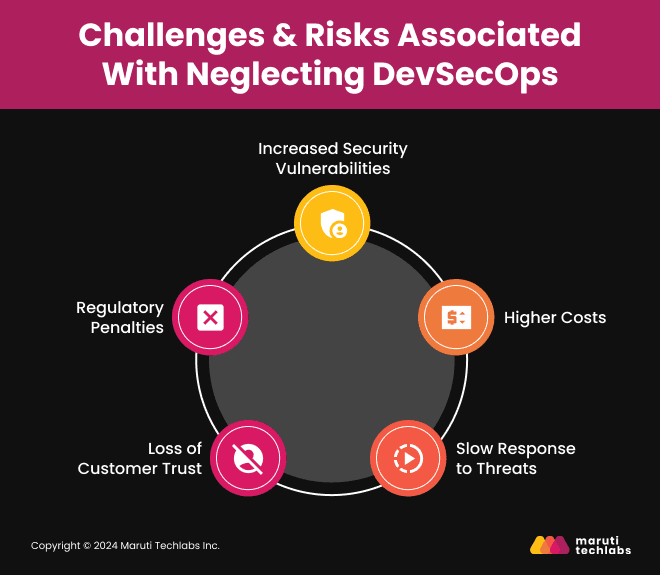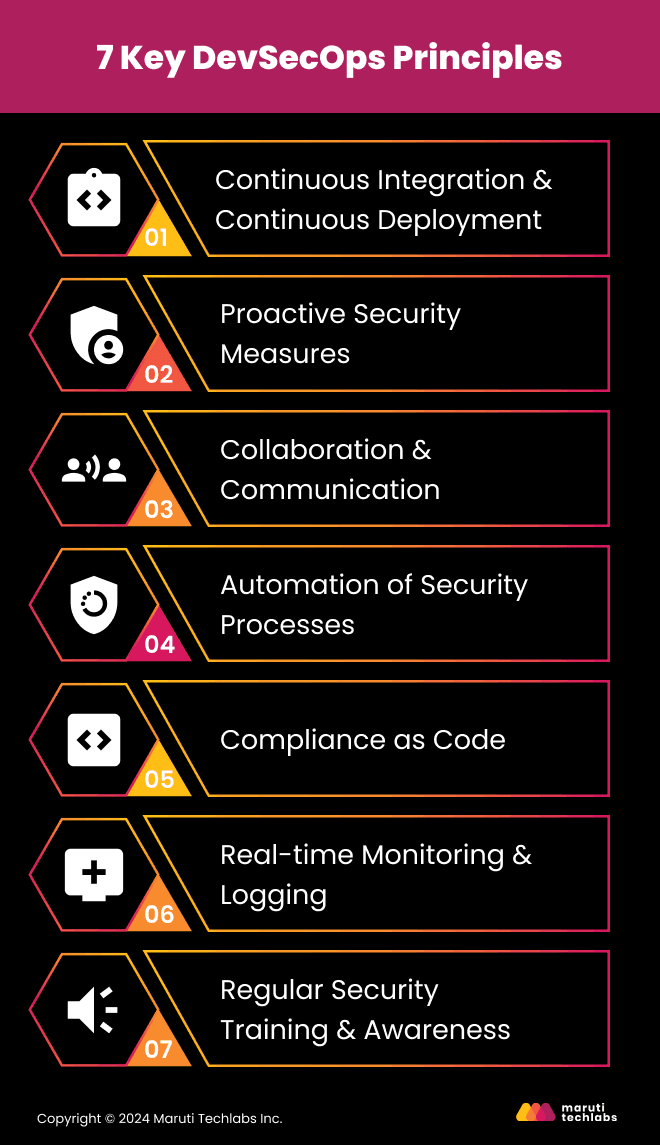

7 Principles to Drive Security in DevOps Processes






DevSecOps is a practical and dependable approach to software development that combines security, development, and operations. It ensures that security is part of every step in the software creation process. By implementing DevSecOps principles, companies can improve data security and reduce risks.
In this guide, you will learn about DevSecOps, its importance, and its benefits to software development. You will also discover the seven key DevSecOps principles that enhance security and streamline development processes. Understanding these principles can help businesses create better and safer applications. So, let’s get started!
DevSecOps represents a transformative approach to integrating security throughout the software development lifecycle. Instead of adding security at the end, DevSecOps makes it a part of every stage, from planning to deployment. Here, security is not just the job of one team; everyone involved in creating the software shares the responsibility.
The role of security in DevOps is crucial. It helps identify and fix vulnerabilities early, preventing problems before they become serious. By embedding DevSecOps throughout the development lifecycle, teams can ensure that applications are safe and reliable.
Understanding the components of DevSecOps is essential.

According to a Gartner report, 66% of organizations experienced fewer security incidents after adopting DevSecOps. It shows how important these principles are for keeping applications safe. Following DevSecOps principles helps create a culture where everyone values security, and building strong and secure applications.
However, there are also risks associated with companies who ignore the implementation of DevSecOps.
Neglecting DevSecOps can lead to several challenges and risks that can harm a company. Here are five key problems:
Without integrating security early, software can have hidden weaknesses. Hackers can exploit these risks, leading to data breaches.
Fixing security issues after deployment is often more expensive than addressing them during development. Companies may also face unexpected costs due to breaches or system failures.
It takes longer to identify and respond to threats without proper security measures. This delay can allow attackers to cause more damage.

If a company suffers a data breach, customers may lose trust and choose not to use its services again. For instance, Target experienced a major data breach in 2013, affecting 40 million credit and debit records and 70 million customer records.
Companies that fail to safeguard user data might face lawsuits. For instance, In 2017, Equifax received a $700 million settlement due to the breach of sensitive information for 147 million people.
Following the principles of DevSecOps can save companies from these risks and help them create safer applications for their users.
Embracing DevSecOps transforms the way teams develop and secure applications. Discover the five key benefits that make this approach a game-changer.
Implementing DevSecOps principles brings many benefits that improve security, speed up deployment, and enhance teamwork. Here are some key advantages:

Businesses may find and address vulnerabilities early on by incorporating security into all phases of development. This proactive strategy safeguards user information and helps prevent data breaches.
Organizations that have embraced DevSecOps have experienced a 60% improvement in quality assurance and a 20% reduction in time to market. It demonstrates how embedding security from the start can lead to safer applications.
With DevSecOps, teams can automate various processes, which speeds up the time it takes to release new features. Companies can respond quickly to market demands and stay competitive.
Netflix exemplifies this benefit by using DevSecOps principles to deploy code thousands of times a day while maintaining strong security measures. This allows them to innovate rapidly without compromising safety.
DevSecOps encourages communication between development, security, and operations teams. This collaboration helps everyone understand their roles in keeping the software secure.
Top American bank holding company Capital One significantly improved its deployment speed after implementing DevSecOps principles. This practice fostered better teamwork across departments and improved overall efficiency.
By catching security issues early, teams spend less time fixing problems later. This efficiency allows them to focus on creating new features instead of constantly putting out fires.
Addressing security concerns during development is much cheaper than fixing them after deployment. Companies save money by avoiding costly breaches.
By embracing DevSecOps, companies can enjoy these benefits and create safer, more efficient applications. Now, let’s observe the key principles of DevSecOps.
Understanding the key DevSecOps principles is essential for improving security and streamlining development.

Here are the seven important principles:
This principle focuses on automatically integrating and deploying code changes. It allows teams to test and release new features quickly. By including security checks in the CI/CD pipeline, teams can respond rapidly to vulnerabilities and deploy security patches without delay.
The security measure emphasizes identifying risks early in the development process. The "shift-left" approach means considering security from the start, which helps create a more assertive security posture. Tools like Static Application Security Testing (SAST) and Dynamic Application Security Testing (DAST) automate security testing to catch issues early.
Effective communication between development, security, and operations teams is crucial. This principle encourages cross-functional teams to work together, reducing misunderstandings and errors in the development process. Regular meetings, shared tools, and open communication channels foster a culture of transparency where all team members are aligned on security goals.
Automating security processes is essential for maintaining consistency and reliability throughout the software development lifecycle. By automating repetitive tasks such as vulnerability scanning and compliance checks, teams can save time and reduce human error. Automated tools can quickly identify security issues across applications, allowing faster remediation efforts.
Compliance as Code is a principle that integrates compliance rules directly into the codebase, ensuring that applications consistently meet regulatory requirements. By embedding compliance checks within the development process, organizations can detect issues early rather than wait for external audits or assessments.
Continuous observation of applications is vital for security. Security Information and Event Management (SIEM) is an effective tool for monitoring, while automated alerts help teams respond quickly to incidents. By implementing effective monitoring practices, organizations can maintain a proactive stance on security and promptly address any threats.
Regular security training alongside awareness programs is essential for informing teams about the latest security best practices and threats. Continuous learning opportunities help employees understand their roles in maintaining application security and foster a culture of vigilance within the organization.
Training sessions can cover secure coding techniques, incident response protocols, and emerging cyber threats.
DevSecOps principles thus help the organization make safer applications and improve teamwork and efficiency.
Understanding and implementing DevSecOps principles is critical for improving data security in software development. By integrating DevSecOps across the development lifecycle, organizations can minimize risks and enhance team collaboration.
The issues with neglecting these practices bring out the need for proactive security, continuous integration, and communication. Implementing DevSecOps brings faster deployments and cost savings and ensures compliance while keeping a watch on things in real time.
DevOps services by Maruti Techlabs help businesses effectively make such practices, with security taking its place from the top. Get in touch with us today to implement DevSecOps practices and for valuable support and guidance. Embrace these principles today to build safer, more efficient applications.
The core DevSecOps principles include continuous integration and deployment, proactive security measures, collaboration and communication, automation of security processes, compliance as code, real-time monitoring, and regular security training.
Implementing DevSecOps principles improves software in all stages by integrating it with security. The result is less vulnerability in deployments, which are highly reliable and also faster, among other things.
Collaboration is key to DevSecOps principles because it brings development, security, and operations teams together. This approach identifies potential security issues early while avoiding misunderstandings, ensuring an efficient development process.
Several tools, including SAST and DAST testing tools for automatically checking for security, support DevSecOps principles like CI/CD pipelines during deployment. SIEM solutions provide real-time monitoring and help ensure adequate security throughout an organization's development lifecycle.
Organizations can begin implementing DevSecOps principles by auditing their current processes, offering training in security best practices, and introducing security tools into their workflows. Gradually implementing such changes will strengthen the security posture and improve development processes.


